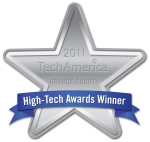What does it take for a good idea to become a good product? To paraphrase one of the honorees at the TechAmerica 18th Annual OC High-Tech Innovation Awards held on June 9th, 2011, invention is about having fun and innovation is about creating value. So what is needed for a product or service to truly innovate and become a new standard?
Some inventions may hold the promise of value but require major changes to the existing infrastructure. While hydrogen fuel cells or electric vehicles may represent the future of the automotive industry, in order to replace the internal combustion engine, we need to figure out how to replace the gas station on every corner. This is going to be a costly endeavor as well as one that the entrenched industry (gas station owners and oil companies) may not be quick to embrace.
When we think of innovation much of what you think of are R&D breakthroughs and bleeding edge technologies that capture the imagination. But those technologies often take years of development and refinement in order for the cost of production to make it affordable to the masses. Innovations like those introduced by Apple in recent years are a notable exception in part due to their ability to source, manufacture, and distribute products on a scale that can keep their costs competitive.
So if you aren’t Apple, how do you create an innovative product that can make it in the market?
With ViridiSTOR, we looked at these issues and developed our solution to address these issues.
On the value front, we looked at the whole product ecosystem from all of the potential stakeholders in the technology. In our case, that includes trade show, event, and conference organizers/owners, exhibitors, presenters, and attendees. From an innovation standpoint, we look at how our solution will impact and improve the experience for each stakeholder.
Our product/service offering allows an event to replace paper-based materials with electronic media. Not only does our product have an environmental benefit, but it provides value to each stakeholder.
- For event organizers, it makes their events greener, reduces costs by freeing up excess storage space, generates new revenue through sponsorship opportunities, and makes the content of their shows more relevant.
- For exhibitors, the solution reduces the cost of printing and shipping materials while allowing them to provide videos, presentations, and other multimedia content to their prospects.
- Finally, for attendees, they no longer have to carry bags full of paper brochures and materials from the booths they visit. Instead they collect information electronically on a USB device and have the ability to sort, categorize, search, compare, and share that information on their computers, a vast improvement over shuffling through catalogs and brochures to find that one piece of information needed.
On the infrastructure front, our solution uses existing technologies that have been re-imagined to create an innovative new process and approach to distributing content. Additionally as they are proven technologies that are readily available there is no need to be concerned over the stability and reliability of the product. So unlike a bleeding edge technology, our solution can be implemented today and at a cost that is lower than the existing method of distributing paper based materials.
With the Green Box Solution, we have looked at the hurdles of introducing innovative products and designed a solution that is efficient, economical, and environmentally friendly. And for that, we have been named to the OC Metro 2011 Green Team and honored by TechAmerica Orange County as the 2011 High-Tech Innovation Award Winner in its Hardware category.

